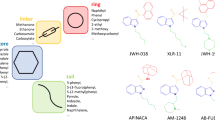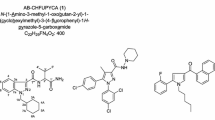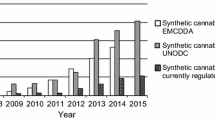Abstract
Two unknown cannabimimetic compounds were detected in a seized herbal mixture after gas chromatography–mass spectrometry (GC–MS) screening. To elucidate the chemical structures, 0.3 g of the dried plant material was extracted with methanol and concentrated under reduced pressure. The extract was purified by silica gel column chromatography with methylene chloride and methanol. Pure compounds were isolated by preparative high-performance liquid chromatography (HPLC) and then analyzed by electrospray ionization (ESI) mass spectrometry (MS) with direct flow injection, high-resolution ESI-time-of-flight (TOF)–MS and one-dimensional and two-dimensional nuclear magnetic resonance (NMR) spectroscopy. GC–MS spectra showed that the base ion at m/z 321 for compound 1 was the same as that of 1-pentyl-3-(4-methoxybenzoyl)indole (RCS-4), and the fragment ions were almost the same as those of RCS-4. The GC–MS spectrum of compound 2 was very similar to that of compound 1 except that the mass numbers of the fragment ions at m/z 290, 200, 186, and 173 of compound 2 were equally smaller than those of compound 1 by 14 amu. From these GC–MS results, compound 1 was assumed to be the 2- or 3-methoxy isomer of RCS-4, and compound 2 was assumed to be a 1-butylindole homologue of compound 1. The ESI mass spectra showed a single peak at m/z 322.33 for compound 1 and a single peak at m/z 308.25 for compound 2, which showed the masses of the protonated ions. High-resolution TOF–MS spectra showed the accurate mass numbers of protonated molecular ions at m/z 322.180512 for compound 1 and at m/z 308.164895 for compound 2, suggesting the molecular formulas of C21H23NO2 and C20H21NO2, respectively. The 1H NMR spectra showed signals that suggested 23 and 21 protons for compounds 1 and 2, respectively, while the respective 13C NMR spectra showed 21 and 20 carbon signals. All protons and carbons were assigned by their couplings and correlations observed in 1H–1H correlation spectroscopy (COSY), 1H–13C heteronuclear multiple bond correlation (HMBC), and 1H–13C heteronuclear single quantum coherence (HSQC) spectra. On the basis of the spectral data, compound 1 was identified as the 2-methoxy isomer of RCS-4; compound 2 was identified for the first time as 1-butyl-3-(2-methoxybenzoyl)indole. Phenazepam and 5-methoxy-N,N-diallyltryptamine (5-MeO-DALT) were also identified as coexisting drugs in the herbal mixture. The contents of compounds 1 and 2 in the mixture were calculated to be 22.4 and 3.45 mg/g, respectively.




Similar content being viewed by others
References
Dresen S, Ferreirós N, Pütz M, Westphal F, Zimmermann R, Auwärter V (2010) Monitoring of herbal mixtures potentially containing synthetic cannabinoids as psychoactive compounds. J Mass Spectrom 45:1186–1194
Kikura-Hanajiri R, Uchiyama N, Goda Y (2011) Survey of current trends in the abuse of psychotropic substances and plants in Japan. Legal Med 13:109–115
EMCDDA (2009) Action on new drugs briefing paper: understanding the ‘Spice’ phenomenon (a report from an EMCDDA expert meeting, 6 March 2009, Lisbon). Updated version, 13 Aug 2009
Auwärter V, Dresen S, Weinmann W, Müller M, Pütz M, Ferreirós N (2009) Spice and other herbal blends: harmless incense or cannabinoid designer drugs? J Mass Spectrom 44:832–837
Uchiyama N, Kikura-Hanajiri R, Kawahara N, Haishima Y, Goda Y (2009) Identification of a cannabinoid analog as a new type of designer drug in a herbal product. Chem Pharm Bull 57:439–441
Uchiyama N, Kikura-Hanajiri R, Kawahara N, Goda Y (2009) Identification of a cannabimimetic indole as a designer drug in a herbal product. Forensic Toxicol 27:61–66
Uchiyama N, Kikura-Hanajiri R, Ogata J, Goda Y (2010) Chemical analysis of synthetic cannabinoids as designer drugs in herbal products. Forensic Sci Int 198:31–38
Nycz JE, Malecki G, Zawiazalec M, Pazdziorek T, Skop P (2010) 1-Pentyl-3-(4-methoxy-1-naphthoyl)indol and 2-(2-methoxy-phenyl)-1-(1-pentyl-1H-indol-3-yl)-ethanone: X-ray structures and computational studies. Mol Struct 984:125–130
Uchiyama N, Kawamura M, Kikura-Hanajiri R, Goda Y (2011) Identification and quantitation of two cannabimimetic phenylacetylindoles JWH-251 and JWH-250, and four cannabimimetic naphthoylindoles JWH-081, JWH-015, JWH-200, and JWH-073 as designer drugs in illegal products. Forensic Toxicol 29:25–37
Nakajima J, Takahashi M, Seto T, Suzuki J (2011) Identification and quantitation of cannabimimetic compound JWH-250 as an adulterant in products obtained via the Internet. Forensic Toxicol 29:51–55
Nakajima J, Takahashi M, Seto T, Kanai C, Suzuki J, Yoshida M, Hamano T (2011) Identification and quantitation of two benzoylindoles AM-694 and (4-methoxyphenyl)(1-pentyl-1H-indol-3-yl)methanone, and three cannabimimetic naphthoylindoles JWH-210, JWH-122, and JWH-019 as adulterants in illegal products obtained via the Internet. Forensic Toxicol 29:95–110
Nakajima J, Takahashi M, Nonaka R, Seto T, Suzuki J, Yoshida M, Kanai C, Hamano T (2011) Identification and quantitation of a benzoylindole (2-methoxyphenyl)(1-pentyl-1H-indol-3-yl)methanone and a naphthoylindole 1-(5-fluoropentyl-1H-indol-3-yl)-(naphthalene-1-yl)methanone (AM-2201) found in illegal products obtained via the Internet and their cannabimimetic effects evaluated by in vitro [35S]GTPγS binding assays. Forensic Toxicol 29:132–141
Nakajima J, Takahashi M, Seto T, Yoshida M, Kanai C, Suzuki J, Hamano T (2012) Identification and quantitation of two new naphthoylindole drugs-of-abuse, (1-(5-hydroxypentyl)-1H-indol-3-yl)(naphthalen-1-yl)methanone (AM-2202) and (1-(4-pentenyl)-1H-indol-3-yl)(naphthalen-1-yl)methanone, with other synthetic cannabinoids in unregulated “herbal” products circulated in the Tokyo area. Forensic Toxicol 30:33–44
Uchiyama N, Kawamura M, Kikura-Hanajiri R, Goda Y (2012) Identification of two new-type synthetic cannabinoids, N-(1-adamantyl)-1-pentyl-1H-indole-3-carboxamide (APICA) and N-(1-adamantyl)-1-pentyl-1H-indazole-3-carboxamide (APINACA), and detection of five synthetic cannabinoids, AM-1220, AM-2233, AM-1241, CB-13 (CRA-13), and AM-1248, as designer drugs in illegal products. Forensic Toxicol 30:114–125
Kneisel S, Bisel P, Brecht V, Broecker S, Müller M, Auwärter V (2012) Identification of the cannabimimetic AM-1220 and its azepane isomer (N-methylazepan-3-yl)-3-(1-naphthoyl)indole in a research chemical and several herbal mixtures. Forensic Toxicol 30:126–134
Huffman JW, Mabon R, Wu M, Lu J, Hart R, Hurst DP, Reggio PH, Wiley JL, Martin BR (2003) 3-Indolyl-1-naphthylmethanes: new cannabimimetic indoles provide evidence for aromatic stacking interactions with the CB1 cannabinoid receptor. Bioorg Med Chem 11:539–549
Huffman JW, Zengin C, Wu M, Lu J, Hynd G, Bushell K, Thompson ALS, Bushell S, Tartal C, Hurst DP, Reggio PH, Selley DE, Cassidy MP, Wiley JL, Martin BR (2005) Structure–activity relationships for 1-alkyl-3-(1-naphthoyl)indoles at the cannabinoid CB1 and CB2 receptors: steric and electronic effects of naphthoyl substituents. New highly selective CB2 receptor agonists. Bioorg Med Chem 13:89–112
Huffman JW, Szklennik PV, Almond A, Bushell K, Selley DE, He H, Cassidy MP, Wiley JL, Martin BR (2005) 1-Pentyl-3-phenylacetylindoles, a new class of cannabimimetic indoles. Bioorg Med Chem Lett 15:4110–4113
Huffman JW, Lu J, Dai D, Kitaygorodskiy A, Wiley JL, Martin BR (2000) Synthesis and pharmacology of a hybrid cannabinoid. Bioorg Med Chem 8:439–447
Marriott KC, Huffman JW, Wiley JL, Martin BR (2006) Synthesis and pharmacology of 11-nor-1-methoxy-9-hydroxyhexahydrocannabinols and 11-nor-1-deoxy-9-hydroxyhexahydrocannabinols: new selective ligands for the cannabinoid CB2 receptor. Bioorg Med Chem 14:2386–2397
Huffman JW, Padgett LW, Isherwood ML, Wiley JL, Martin BR (2006) 1-Alkyl-2-aryl-4-(1-naphthoyl)pyrroles: new high affinity ligands for the cannabinoid CB1 and CB2 receptors. Bioorg Med Chem Lett 16:5432–5435
Huffman JW, Bushell SM, Joshi SN, Wiley JL, Martin BR (2006) Enantioselective synthesis of 1-methoxy-and 1-deoxy-2′-methyl-Δ8-tetrahydrocannabinols: new selective ligands for the CB receptor. Bioorg Med Chem 14:247–262
Yates AY, Doughty SW, Kendall DA, Kellam B (2005) Chemical modification of the naphthoyl 3-position of JWH-015: in search of a fluorescent probe to the cannabinoid CB2 receptor. Bioorg Med Chem Lett 15:3758–3762
Lindigkeit R, Boehme A, Eiserloh I, Luebbecke M, Wiggermann M, Ernst L, Beuerle T (2009) Spice: a never ending story? Forensic Sci Int 191:58–63
Vardakou I, Pistos C, Spiliopoulou Ch (2010) Spice drugs as a new trend: mode of action, identification and legislation. Toxicol Lett 197:157–162
Every-Palmer S (2011) Synthetic cannabinoid JWH-018 and psychosis: an explorative study. Drug Alcohol Depend 117:152–157
Corkery JM, Schifano F, Ghodse AH (2012) Phenazepam abuse in the UK: an emerging problem causing serious adverse health problems, including death. Hum Psychopharmacol 27:254–261
Maskell PD, Paoli GD, Seetohul LN, Pounder DJ (2012) Phenazepam: the drug that came in from the cold. J Forensic Legal Med 19:122–125
Aung MM, Griffin G, Huffman JW, Wu M, Keel C, Yang B, Showalter VM, Abood ME, Martin BR (2000) Influence of the N-1 alkyl chain length of cannabimimetic indoles upon CB(1) and CB(2) receptor binding. Drug Alcohol Depend 60:133–140
Acknowledgments
The authors thank Prof. D.C. Moon of Chungbuk National University of South Korea for valuable discussion on the GC–MS results.
Author information
Authors and Affiliations
Corresponding authors
Rights and permissions
About this article
Cite this article
Park, Y., Lee, C., Lee, H. et al. Identification of a new synthetic cannabinoid in a herbal mixture: 1-butyl-3-(2-methoxybenzoyl)indole. Forensic Toxicol 31, 187–196 (2013). https://doi.org/10.1007/s11419-012-0173-2
Received:
Accepted:
Published:
Issue Date:
DOI: https://doi.org/10.1007/s11419-012-0173-2




